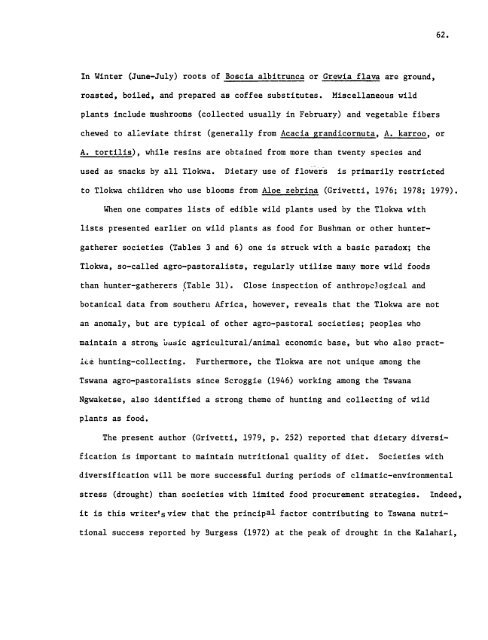BIBLIOGRAPHIC DATA SHEET
BIBLIOGRAPHIC DATA SHEET
BIBLIOGRAPHIC DATA SHEET
Create successful ePaper yourself
Turn your PDF publications into a flip-book with our unique Google optimized e-Paper software.
In Winter (June-July) roots of Boscia albitrunca or Grewia flava are ground,<br />
roasted, boiled, and prepared as coffee substitutes. Miscellaneous wild<br />
plants include mushrooms (collected usually in February) and vegetable fibers<br />
chewed to alleviate thirst (generally from Acacia grandicornuta, A. karroo, or<br />
A. tortilis), while resins are obtained from more than twenty species and<br />
used as snacks by all Tlokwa. Dietary use of flowers is primarily restricted<br />
to Tlokwa children who use blooms from Aloe zebrina (Grivetti, 1976; 1978; 1979).<br />
When one compares lists of edible wild plants used by the Tlokwa with<br />
lists presented earlier on wild plants as food for Bushman or other hunter<br />
gatherer societies (Tables 3 and 6) one is struck with a basic paradox; the<br />
Tlokwa, so-called agro-pastoralists, regularly utilize many more wild foods<br />
than hunter-gatherers (Table 31). Close inspection of anthropological and<br />
botanical data from southern Africa, however, reveals that the Tlokwa are not<br />
an anomaly, but are typical of other agro-pastoral societies; peoples who<br />
maintain a strong basic agricultural/animal economic base, but who also pract<br />
!Le hunting-collecting. Furthermore, the Tlokwa are not unique among the<br />
Tswana agro-pastoralists since Scroggie (1946) working among the Tswana<br />
Ngwaketse, also identified a strong theme of hunting and collecting of wild<br />
plants as food.<br />
The present author (Grivetti, 1979, p. 252) reported that dietary diversi<br />
fication is important to maintain nutritional quality of diet. Societies with<br />
diversification will be more successful during periods of climatic-environmental<br />
stress (drought) than societies with limited food procurement strategies. Indeed,<br />
it is this writer's view that the principal factor contributing to Tswana nutri<br />
tional success reported by Burgess (1972) at the peak of drought in the Kalahari,<br />
62.

















